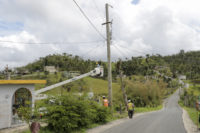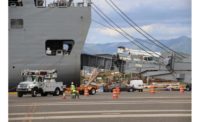
On Sept. 20, 2017, Hurricane María visited Puerto Rico, bringing with it cataclysmic destruction unparalleled in the last 100 years. María’s winds left an already debilitated electrical grid totally useless. A Class 4 direct hit, the first in 90 years and the only direct hit in modern history.
The entire overhead aerial electric grid had come crashing to the ground after endless hours of 155 mph winds. Thousands of lattice work towers were destroyed or damaged and an estimated 50,000 poles were down and in need of replacement. There was no stock of materials to rebuild with. The lattice tower grid, built across the island’s mountains, had delivered power from generation in the south to the densely populated north and eastern shores. All the island’s power plants were severely damaged and most were completely or partially offline. The rudimentary preliminary restoration of service took the Corps of Engineers and thousands of local and stateside contractors, billions of dollars and a year to accomplish. Today, 99% of the population is back online, but hundreds of FEMA generators remain in service.
So now the island is now faced with the enormous task of building a resilient generation, transmission and distribution (T&D) system. That system will include decentralizing and privatizing power plants that will be dispersed around the island. Both large renewable energy and alternative energy micro grid P3’s will be built. These proposals will be a mixed bag of design/build and turnkey proposals.
It is estimated it will take $12 to $14 billion in federal funds and four to five years of work to rebuild the T&D systems. PREPA has hired stateside and local engineering firms who have conceptualized the new improved PREPA. It has been announced recently the T&D systems will be administered and maintained by a private sector administrator. That process is in the RFP stage. It's expected that the administrator will be in place next year.
The good news is that after going through four executive directors in two years, the island’s power company has a new leader drafted from the private sector with an excellent track record. Jose Ortíz, the new CEO of the Puerto Rico Electric Power Authority (PREPA), has a history of getting things built in his past roles with infrastructure construction.
Multiple pretenders and proposers are lining up to buy existing antiquated power plants, others are proposing to build all new generation facilities of all varieties in existing brown fields and others in green fields. The government has set up an expanded P3 facilitator agency, directed by Omar Marrero, called COR3. Marrero, as well as Ortiz at PREPA, are highly efficient public servants. Their skills as administrators will be tested by fire. The partisan politics of the central government will bring enormous pressure on them to hire cronies. However, federal and local oversight boards have been created to insure the plan stays on point.
On the T&D side, undergrounding large segments of transmission system around the new power generation facilities will be realized. More resilient overhead systems and a conversion to Rural Utility Service specifications will be in the plan. The RUS/USDA construction standards will create uniformity and make it easier to secure materials from stateside suppliers in the next emergency.
Democratic politicians from the Northeast are lobbying the governor big time for their unions and unionized contractors to be included in all facets of the rebuilding. The island government’s quid pro quo with those politicians is using their influence in Congress to secure more and more funds. The jury is still out on how much federal funding from FEMA, CBDG, HUD, USACE, RUS, FWHA, EFL, FCC and others will arrive and how much of money will stay in Puerto Rico. The scramble is on from large national and multinational entities who are lobbying aggressively to get their piece of the action. Locally, we are scrambling to insure observance of the Stafford Act, to protect local contractor members.
After the initial mitigation was accomplished, stateside contractors Cobra/Mammoth, Mastec and Foreman were given open-ended contracts to continue the rebuilding. Cobra is doing a design build microgrid for the island’s municipalities of Vieques and Culebra. Mastec and Foremen were awarded contracts but have been used sparingly or not at all to date. The future will see hard bid contracts for T&D.
We, at AGCPR, have launched a multi-pronged initiative to educate and attract new and existing talent to our workforce. We are also creating alliances at both the local level and across borders to address the needs we see developing. We are educating on lean construction concepts. We remain confident that PREPA and Core3 will work to insure vigilance and adherence to the Stafford Act to create maximum involvement of local resources. We remain optimistic about our abilities to be the leading protagonist in Building Back a Better and more Resilient Puerto Rico.
Stephen Spears is president of the Puerto Rico Chapter of the Associated General Contractors of America.





Post a comment to this article
Report Abusive Comment